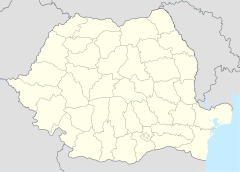| Kornis Castle | |
|---|---|
| Romanian: Castelul Kornis Hungarian: Kornis-kastély | |
 Kornis Castle, vintage engraving Kornis Castle, vintage engraving | |
 | |
| General information | |
| Architectural style | Renaissance |
| Location | Mănăstirea, Cluj County |
| Country | Romania |
| Coordinates | 47°07′06.7″N 23°55′15.9″E / 47.118528°N 23.921083°E / 47.118528; 23.921083 |
| Construction started | 1573 |
| Completed | 1593 |
| Design and construction | |
| Architect(s) | Kristof Kereszturi |
Kornis Castle is a castle begun in the 16th century and located in Mănăstirea village, Cluj County, Romania. It is listed as a historic monument by the country's Culture Ministry.
History
The main building was built by Kristóf Keresztúri between 1573 and 1593 in the Renaissance style. Over time, the castle was filled with secondary buildings in a quadrilaterally shaped enclosure. After the domain became the property of the Kornis family around 1673, Kornis Gaspar (1641-1683) raised the second floor of the main building on the south side.
In 1680, his son, Zsigmond Kornis, renovated the castle. He also repaired the castle after it was damaged during the Curuti uprising in the early 18th century and in 1720 added two new octagonal bastions on the northern side and restored the tower at the castle entrance on the west side. The tower still exists today. During this period the castle rooms were redecorated with frescoed ceilings. The wooden frame works of the top floor and staircase were added, decorated with popular motifs and decorations of Dej volcanic tuff stone were created.
During the Second World War part of the castle was destroyed and its collections were burned by the communists or stolen after nationalization. Before the destruction of the castle, the library contained 9,000 volumes, consisting of collections of rare books. It was destroyed together with the extensive natural history collection. The pavilions are now used as a silo, hostel and cultural school destinations.
After 1944, only part of the masonry was rebuilt in 1975-76 and Kornis chapel was taken over by the Romanian Orthodox Church. But there was no serious restoration of the castle and the domain, leaving the castle in ruins today. The castle is known for the statues of two unicorns which guarded the entry until recently, when they were removed after a failed burglary attempt.
Photo gallery
-
Tower entrance
-
Octagonal fountain
-
Ruins of the castle
-
Coat of arms on one of the buildings
-
Coat of arms
-
Unicorn
-
Coat of arms of the Kornis family
-
Adjacent building
References
- (in Romanian) Lista Monumentelor Istorice 2010: Judeţul Cluj
- Un castel cu Inorogi Archived 2012-01-23 at the Wayback Machine, 25 June 2007, Toma Roman Jr, Jurnalul Național, accessed July 5, 2012
- Liviu Stoica et al., p. 32
- "Inorogii de la Castelul Kornis de la Mănăstirea urmau să fie furaţi. S-au găsit frânghii. Ce s-a întâmplat cu ei".
Bibliography
- Repertoriul arheologic al județului Cluj, Cluj-Napoca, 1992.
External links
- Burgenwelt (Information about the castle) Archived 2009-07-05 at the Wayback Machine
- Burgenwelt (Photos with the castle) Archived 2009-07-05 at the Wayback Machine
- Castelul Kornis at art-historia
- A castle with Unicorns Archived 2012-01-23 at the Wayback Machine, 25 iunie 2007, Toma Roman Jr, Jurnalul Național
